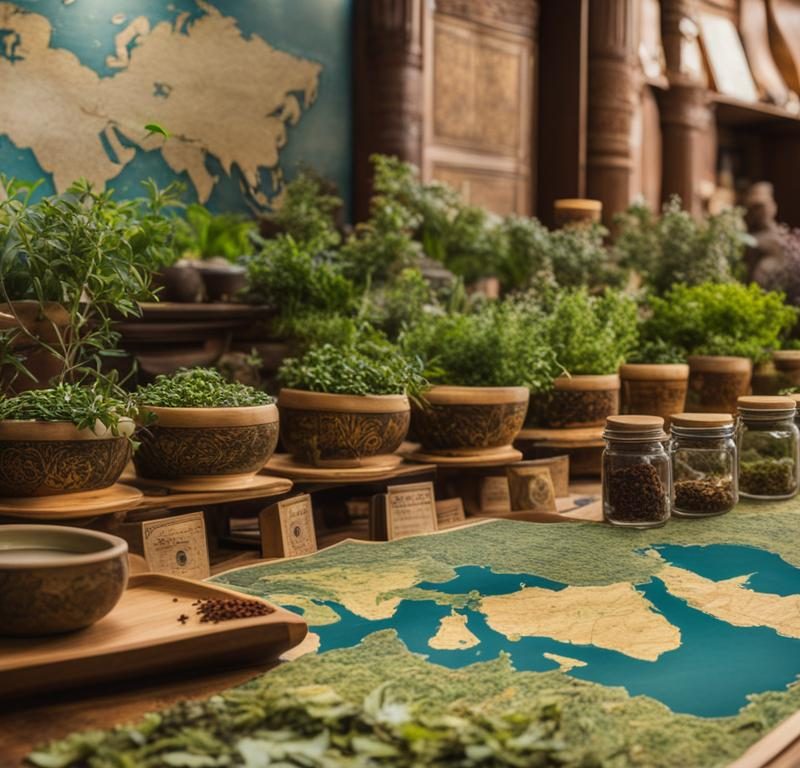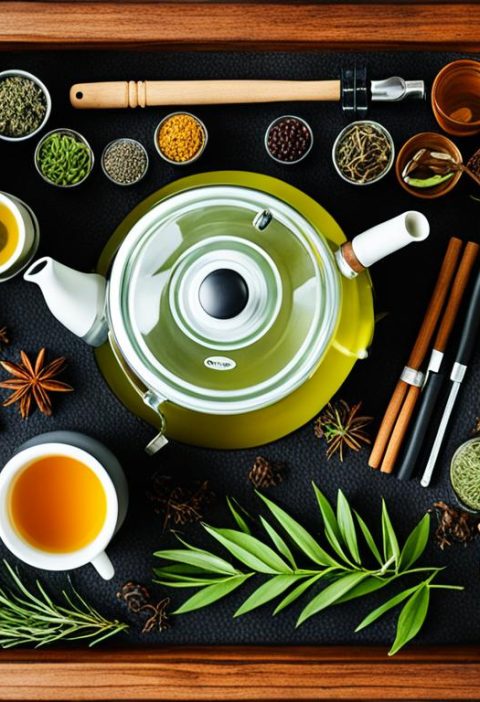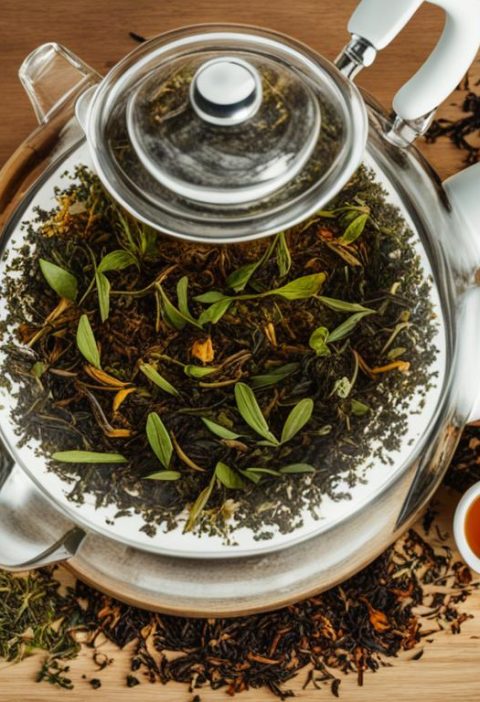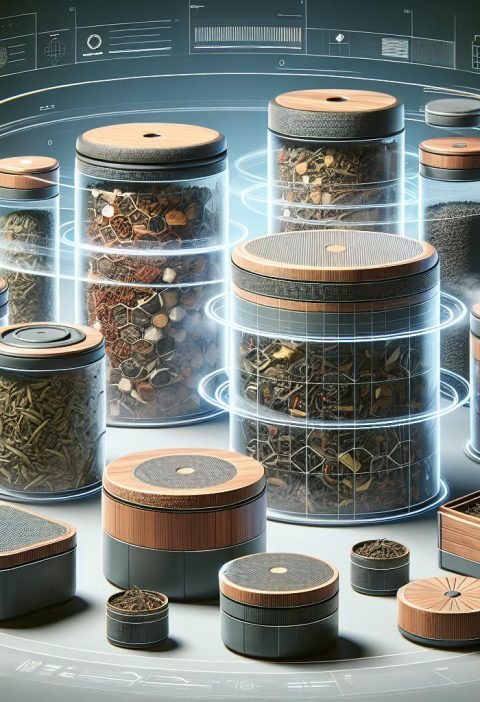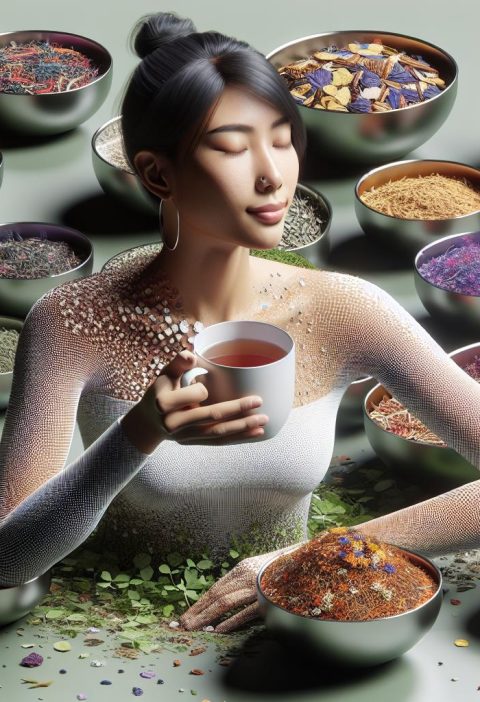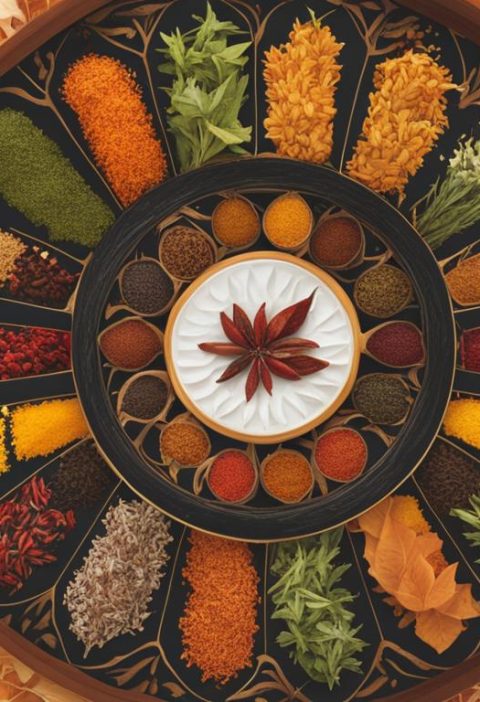Herbal teas have a rich history and are appreciated for their diverse flavors and reputed health benefits. They have been enjoyed for centuries by civilizations worldwide. Understanding the ingredients and the art of blending herbal teas contributes to the unique taste and aroma profiles. Exploring the variety of herbal teas available, including the infusion of cannabis, presents a modern evolution in the ancient practice of herbal remedies. Brewing a perfect cup of herbal tea requires attention to detail in temperature, quality of herbs, and steeping time. Embarking on the journey of exploring herbal tea tasting characteristics offers a world of flavors and aromas to discover.
The Rich History of Herbal Teas
Herbal teas have a long history, with ancient civilizations embracing them for their wellness benefits. In China, the ritual of herbal tea drinking dates back to the Shang dynasty. Egyptian culture also utilized herbs like chamomile and mint for medicinal purposes. The history of herbal teas adds depth and tradition to each cup enjoyed today.
Key Takeaways
- Herbal teas have been enjoyed for centuries by civilizations worldwide.
- The rich history of herbal teas adds depth and tradition to each cup.
Understanding Herbal Tea Ingredients
Each ingredient in herbal teas contributes not only to the flavor but also to the overall wellness benefits. For example, chamomile is known for its gentle sedative effects, while peppermint aids digestion. Ginger, on the other hand, aids in digestion and combats nausea. These herbs have been used for generations as natural remedies.
Key Takeaways
- Herbal tea ingredients offer both flavor and wellness benefits.
- Chamomile, peppermint, and ginger are popular herbal tea ingredients with specific benefits.
The Art of Blending Herbal Teas
Blending herbal teas is a meticulous process, similar to blending scents by a perfumer. The goal is to create a harmonious blend where each herb contributes to the overall flavor profile and therapeutic properties. Factors such as the temperature at which each herb releases its optimal flavors and how the flavors evolve over time are considered. Master blenders pay close attention to detail to ensure a balanced and flavorful cup of herbal tea.
Key Takeaways
- The art of blending herbal teas involves creating a harmonious blend of flavors and therapeutic properties.
- Temperature and timing play a crucial role in the blending process.
The Rich History of Herbal Teas
Herbal teas have a long history, with ancient civilizations embracing them for their wellness benefits. In China, the ritual of herbal tea drinking dates back to the Shang dynasty. Egyptian culture also utilized herbs like chamomile and mint for medicinal purposes. The history of herbal teas adds depth and tradition to each cup enjoyed today.
As we delve into the diverse world of herbal teas, it is essential to appreciate the rich history behind these soothing beverages. From ancient herbal remedies to modern wellness practices, herbal teas have stood the test of time, offering comfort and nourishment for both body and soul.
Historical Significance
Tea-drinking traditions have been an integral part of various cultures for centuries, each with its unique customs and beliefs. Let’s explore some highlights of herbal tea’s journey throughout history:
| Culture | Herbal Tea | Significance |
|---|---|---|
| China | Various herbal blends | The Shang dynasty introduced herbal tea as a medicinal practice, promoting overall well-being and balance. |
| Egypt | Chamomile, Mint | Ancient Egyptians used herbs for their healing properties, enjoying herbal infusions for relaxation and digestive benefits. |
| Greece | Mountain Tea | The Greeks cultivated and consumed teas made from local mountain herbs, valuing them for their invigorating and detoxifying properties. |
| India | Ayurvedic blends | Ayurvedic traditions incorporated herbal teas, known as “Kadha” or “Kashayam,” featuring a range of spices and herbs for holistic wellness. |
Herbal teas have been cherished by different cultures worldwide, offering comfort, healing, and a connection to nature’s bountiful remedies.
Join us in the next section as we dive into the fascinating world of herbal tea ingredients, uncovering the unique flavors and wellness benefits they bring to our cups.
Understanding Herbal Tea Ingredients
Each ingredient in herbal teas contributes not only to the flavor but also to the overall wellness benefits. For centuries, herbs have been used as natural remedies due to their therapeutic properties. Let’s explore some common herbal tea ingredients and their health benefits:
Chamomile: Known for its gentle sedative effects, chamomile is often used to promote relaxation and improve sleep quality.
Peppermint: Aids digestion and helps relieve symptoms such as bloating, gas, and indigestion.
Ginger: Renowned for its digestive benefits, ginger aids in digestion, reduces nausea, and helps alleviate stomach discomfort.
These herbs are just a few examples among many others that can be found in herbal teas. Combining different ingredients allows for a myriad of flavor profiles and health benefits in each cup.
Now, let’s take a closer look at the specific herbs commonly found in herbal teas and their respective properties:
| Herb | Flavor | Health Benefits |
|---|---|---|
| Chamomile | Floral, slightly sweet | Relaxation, sleep aid, anti-inflammatory |
| Peppermint | Cooling, refreshing | Digestive aid, headache relief, congestion relief |
| Ginger | Spicy, warming | Digestive aid, anti-inflammatory, immune support |
This table showcases a small selection of herbal tea ingredients and their notable characteristics. As you continue to explore different herbal teas, you’ll encounter a wide variety of flavors and health benefits.
Next, we’ll dive into the art of blending herbal teas, where these ingredients come together to create unique and delightful flavor combinations.
The Art of Blending Herbal Teas
Blending herbal teas is a meticulous process, requiring the skills and expertise of a master blender. Similar to blending scents by a perfumer, the goal is to create a harmonious blend where each herb contributes to the overall flavor profile and therapeutic properties of the tea. With careful consideration of factors such as the temperature at which each herb releases its optimal flavors and how the flavors evolve over time, master blenders craft blends that are both balanced and full of flavor.
When blending herbal teas, we carefully select and combine different herbs to create a unique and enjoyable tea-drinking experience. Each herb brings its own distinctive characteristics, such as floral, earthy, or spicy flavors, which, when combined with other herbs, create complex and layered taste profiles.
One aspect that master blenders pay close attention to is the temperature at which each herb releases its flavors. Some herbs, like chamomile, require lower temperatures for their delicate flavors to shine, while others, like ginger, require higher temperatures for their spicy notes to develop fully. By understanding the optimal temperatures for each herb, blenders can ensure that the flavors are balanced and not overpowering.
Another key consideration in the art of blending herbal teas is how the flavors evolve over time. Some herbs impart their flavors immediately upon brewing, while others release their flavors gradually as the tea steeps. By carefully selecting herbs that complement each other and considering their steeping times, master blenders create teas that offer a delightful progression of flavors from the first sip to the last.
Blend is everything when it comes to herbal teas. It’s the artful combination of various herbs that makes each cup a unique experience. Like a perfumer blending scents, the master blender skillfully blends the herbs to create a symphony of flavors.
Experience the art of blending yourself by exploring a range of herbal tea blends. Discover the nuances and complexities of different herbs as they come together to create a cup of tea that is both satisfying and soothing.
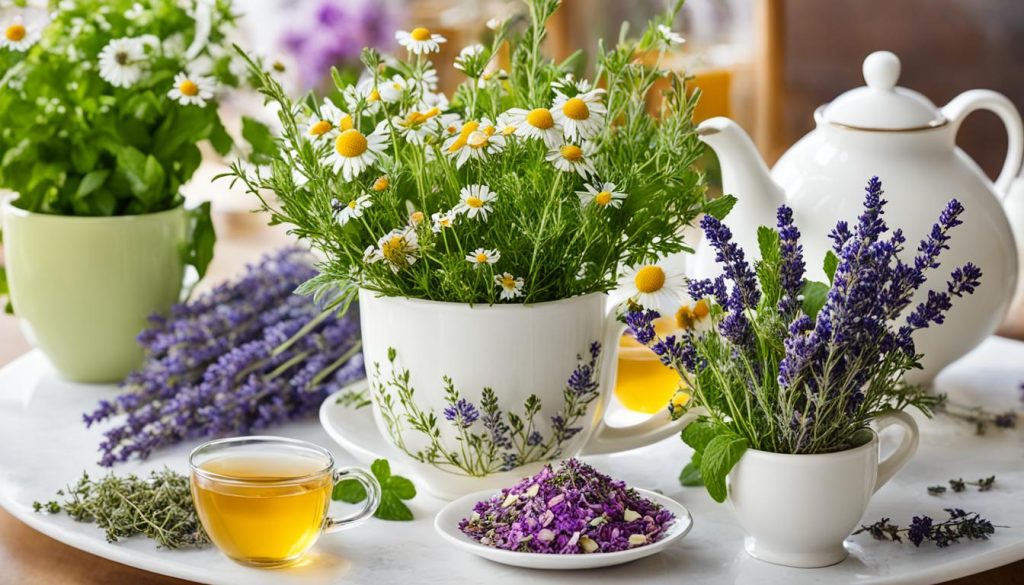
Popular Herbal Tea Blends
| Blend | Ingredients | Taste Profile | Health Benefits |
|---|---|---|---|
| Chamomile Lavender Blend | Chamomile, lavender | Floral, soothing | Relaxation, better sleep |
| Mint Ginger Blend | Peppermint, ginger | Cooling, spicy | Digestive health, nausea relief |
| Rosehips Hibiscus Blend | Rosehips, hibiscus | Tangy, fruity | Rich in vitamin C, immune support |
Exploring Unique Herbal Tea Varieties
When it comes to herbal teas, there is so much more to discover beyond the popular chamomile and ginger varieties. The world is brimming with unique herbal teas that offer a delightful array of flavors and aromas. These lesser-known herbal teas are a treasure trove waiting to be explored by tea enthusiasts.
One such unique herbal tea is Rooibos, a herb native to South Africa. Known for its distinctive sweet and earthy profile, Rooibos tea offers a soothing and satisfying cup. Its natural sweetness makes it a popular choice for those looking to cut back on refined sugars while enjoying a flavorful tea experience.
If you’re in the mood for something with floral notes, lavender tea is a must-try. Made from the aromatic lavender flower, this herbal tea releases a gentle and calming fragrance with every sip. Lavender tea is known for its soothing properties and is often enjoyed before bedtime to promote relaxation and better sleep.
Exploring unique herbal tea varieties is an exciting journey that takes us on a global adventure. It allows us to experience the diverse flavors and health benefits offered by different herbs. Each herbal tea has its own distinct personality, inviting us to expand our tea horizons and indulge in a world of delightful sensations.
Expand Your Tea Collection:
- Nettle tea: Known for its detoxifying properties and earthy flavor.
- Hibiscus tea: Offers a vibrant red color and a tart and tangy taste.
- Lemongrass tea: Delivers a refreshing and citrusy flavor, perfect for a summer sip.
- Peppermint tea: Provides a cooling and invigorating sensation, ideal for soothing digestion.
- Chicory root tea: Offers a deep and robust flavor, often used as a coffee substitute.
With so many unique herbal tea varieties available, you can curate a diverse collection that caters to different moods and occasions. Whether you’re seeking relaxation, a burst of flavor, or specific health benefits, the world of herbal teas has something special to offer.
Cannabis in Herbal Teas: A Deep Dive
The infusion of cannabis, particularly CBD, in herbal teas brings a modern twist to the ancient practice of herbal remedies. Cannabis, a plant renowned for its psychoactive effects, has long been used for medicinal and recreational purposes. CBD, one of the non-psychoactive compounds found in cannabis, offers potential benefits such as anxiety relief and improved sleep. When combined with herbal teas, CBD complements the wellness benefits of tea, creating a unique and holistic experience.
Controlled amounts of THC, the compound responsible for cannabis’s psychoactive effects, can also add a unique dimension to the tea-drinking experience. With careful dosage and mindful consumption, THC-infused herbal teas can provide relaxation and an enhanced sense of well-being. However, it’s important to note that the effects of THC can vary from person to person, and it’s advisable to start with low doses and gradually increase as needed.
Growing cannabis for personal use allows for customization and a deeper connection to the tradition of using medicinal plants. Cultivating cannabis at home ensures the quality and purity of the plants, allowing tea enthusiasts to have full control over the ingredients in their cannabis-infused herbal teas. Whether it’s for individual wellness or to share a unique tea-drinking experience with friends, growing and incorporating cannabis into herbal teas is a personal journey that offers both enjoyment and a deeper appreciation for the power of plants.
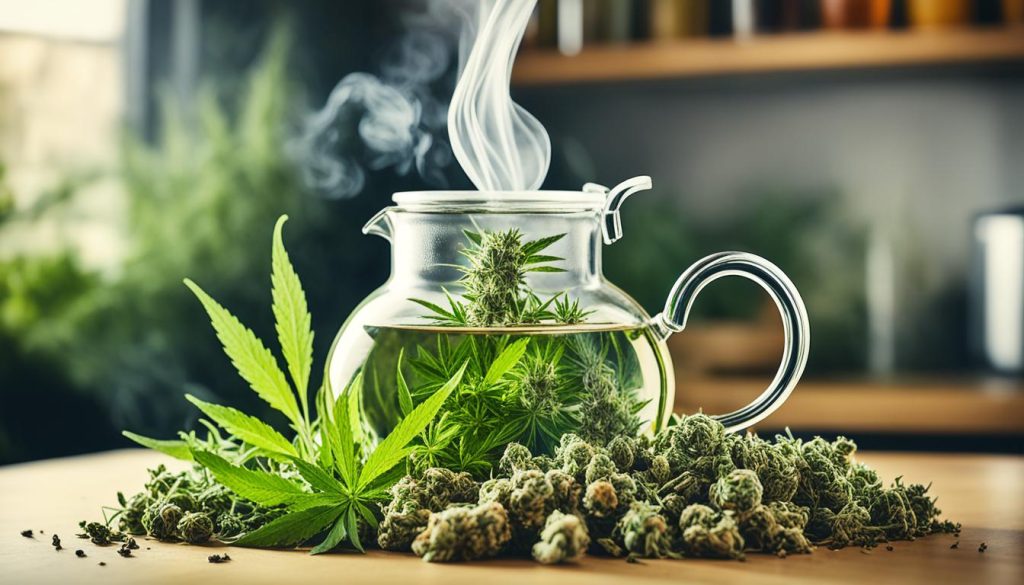
Exploring the Benefits of Cannabis in Herbal Teas:
- Relief from anxiety and stress
- Improved sleep quality
- Potential pain relief
- Enhanced relaxation
Experimenting with Cannabis-infused Tea Blends:
When creating cannabis-infused tea blends, it’s essential to balance the flavors and effects of cannabis with other herbs. Start with familiar herbs like chamomile, lavender, or mint and gradually introduce small amounts of cannabis to find the perfect balance. Pay attention to the flavors, aromas, and effects of each blend, allowing creativity and personal taste preferences to guide the process.
Brewing Cannabis-infused Herbal Teas:
The brewing process for cannabis-infused teas is similar to that of regular herbal teas. However, it’s important to note that cannabinoids are fat-soluble, meaning they bind better to fats and oils. Adding a source of fat, such as coconut oil or butter, is recommended to enhance the extraction of cannabinoids during steeping. Follow the brewing instructions for each herb in the blend, ensuring the optimal temperature and steeping time for a flavorful and therapeutic cup of cannabis-infused herbal tea.
Creating Your Own Cannabis-Infused Tea Blends
Creating cannabis-infused tea blends requires creativity and moderation. It’s all about balancing the flavors and properties of cannabis with other herbs to achieve a harmonious blend that tantalizes the taste buds and offers a delightful tea-drinking experience. Starting with familiar herbs and gradually incorporating cannabis allows for experimentation, enabling you to find the perfect balance of flavor and effects.
When it comes to personalizing your cannabis-infused tea blend, the possibilities are endless. You can choose from a wide range of herbs, spices, and botanicals that complement and enhance the natural flavors of cannabis. Whether you prefer the soothing qualities of chamomile, the zesty notes of lemon verbena, or the invigorating taste of mint, there are countless herbs to explore and incorporate into your custom blend.
Here are some tips to guide you in creating your ideal cannabis-infused tea blend:
- Start with a solid foundation: Begin by selecting a base herb or blend of herbs that serve as the backbone of your tea. These herbs will provide the main flavor and body of your infusion.
- Experiment with complementary flavors: Once you have a base herb, consider adding complementary herbs, spices, or fruits to enhance the taste and aroma of your tea blend. This is where you can get creative and explore different combinations to find what appeals to your palate.
- Consider the desired effects: Certain herbs and botanicals have specific properties that can complement the effects of cannabis. For example, adding lavender or chamomile to your blend can enhance relaxation, while ginger or lemongrass can provide an energizing kick.
- Pay attention to proportions: As you experiment with different herbs and cannabis strains, it’s important to find the right balance. Start with small quantities of cannabis and gradually increase as desired, keeping in mind that the effects can vary based on the strain and dosage.
- Document your recipes: Once you create a cannabis-infused tea blend that you love, make sure to write down the recipe. This way, you can recreate it in the future or share it with friends who might be curious about your unique creation.
Remember, creating your own cannabis-infused tea blends is an art form that allows you to tailor the flavors and effects to your personal preferences. Whether you’re seeking relaxation, focus, or simply a flavorful beverage, exploring the world of cannabis-infused teas opens up a world of possibilities.
So grab your favorite herbs, select a high-quality cannabis strain, and embark on a journey of flavor and experimentation as you create your very own cannabis-infused tea blends.
Brewing the Perfect Cup of Herbal Tea
When it comes to brewing herbal tea, attention to detail is key. Factors such as water temperature, the quality of herbs, and steeping time all play a crucial role in achieving the perfect cup. Each herb has its own optimal temperature and steeping time, allowing it to release its full flavor and therapeutic benefits.
Personalization and experimentation are encouraged when brewing herbal tea. By adapting brewing methods to individual preferences, one can create a truly customized and satisfying tea-drinking experience. Finding the perfect balance of flavors and strengths is a delightful journey in itself.
Water Temperature
Choosing the right water temperature is essential for brewing herbal tea. Different herbs require different temperatures to extract their optimal flavor. In general, hotter water is needed for robust herbs such as ginger or lemongrass, while more delicate herbs like chamomile and lavender prefer slightly cooler water.
Quality of Herbs
Using high-quality herbs ensures that the flavors and therapeutic properties are preserved. It’s important to source herbs from reputable suppliers to guarantee freshness and purity. Organic options are also available, providing a more natural and sustainable choice.
Steeping Time
Steeping time is another crucial factor in brewing herbal tea. To avoid bitterness, it’s important not to oversteep the tea. Most herbal teas require a steeping time of 5-10 minutes, but this can vary depending on the specific herb used. Some herbs, such as chamomile, can be steeped for longer periods without negatively affecting the flavor.
| Herb | Optimal Steeping Time |
|---|---|
| Peppermint | 5 minutes |
| Lavender | 5 minutes |
| Chamomile | 10 minutes |
| Ginger | 5 minutes |
Experimentation is key to finding the perfect brewing method for your favorite herbal teas. By adjusting brewing parameters such as water temperature and steeping time, you can discover new flavors and subtleties in each cup. Enjoy the process of brewing and savor the aromas that fill the air.
Tea Tasting: Exploring Flavors and Aromas
Tea tasting is a rewarding experience that allows individuals to explore the diverse flavors and aromas of different tea varieties. By paying attention to the aroma, flavor, and body of the tea, one can develop their palate and appreciate the nuances of each tea. Different types of tea, such as black, green, white, oolong, and herbal, have distinct tasting notes and characteristics that can be explored through the tea-tasting process.
Understanding Tea Tasting
Tea tasting is an art and a science that involves engaging our senses to fully experience the complexities of each cup. Here is a guide to help you navigate the world of tea flavors and aromas:
- Appearance: Observe the color and clarity of the tea. Different types of tea have unique hue variations, ranging from pale to deep shades.
- Aroma: Inhale deeply and savor the aroma of the brewed tea. Allow the fragrance to envelop your senses, noting any floral, fruity, or earthy undertones.
- Flavor: Take small sips and let the tea coat your tongue. Pay attention to the flavors that emerge, such as sweet, bitter, or vegetal notes. Each sip reveals new layers and complexities.
- Body: Consider the weight and texture of the tea in your mouth. Is it light and delicate or rich and robust? The body of the tea contributes to the overall drinking experience.
- Finish: Notice the lingering aftertaste that remains in your mouth. Some teas have a smooth, lingering finish, while others may leave a slight astringency.
The art of tea tasting allows you to appreciate the unique characteristics of each tea variety, from subtle floral notes in white tea to the bold, malty flavors of black tea.
Exploring Tea Flavors and Aromas
Each type of tea offers a distinct range of flavors and aromas. Let’s dive into the characteristics of some popular tea varieties:
| Tea Variety | Tasting Notes |
|---|---|
| Black Tea | Rich, robust, malty, with hints of caramel and dark chocolate. |
| Green Tea | Fresh, grassy, vegetal, with a delicate sweetness. |
| White Tea | Subtle, floral, with flavors of honey and melon. |
| Oolong Tea | Orchid-like, fruity, with varying degrees of oxidation. |
| Herbal Tea | Herbaceous, floral, fruity, with a wide range of flavor profiles. |
Exploring the vast array of tea flavors and aromas allows tea enthusiasts to discover their personal preferences and expand their tea collection. From the bold and robust to the delicate and soothing, there is a tea for every palate.
Conclusion
Exploring herbal tea tasting characteristics offers a delightful journey of discovery and appreciation for the diverse flavors and aromas that nature has to offer. Whether you choose to indulge in classic herbal teas or venture into cannabis-infused blends, each cup presents a unique and enchanting experience for the senses.
By brewing herbal tea with meticulous attention to detail and personalizing it to suit your individual preferences, you can create a truly rewarding and satisfying tea-drinking experience. The art of blending herbs, understanding their properties, and finding the perfect balance of flavors is key to unlocking the full potential of each sip.
Embark on the captivating journey of exploring herbal tea tasting characteristics and uncover a vibrant world of flavors and aromas waiting to be discovered and enjoyed. With every cup, you have the opportunity to immerse yourself in the rich history of herbal teas and harness the many wellness benefits they offer. Let the soothing warmth of herbal tea envelop you and transport your taste buds to new realms of delight.
